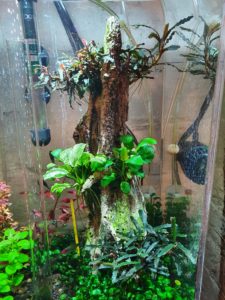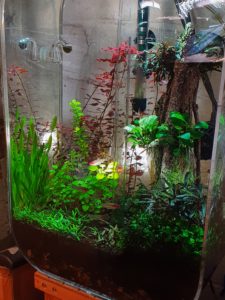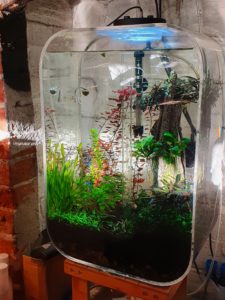Appropriate aquarium lighting is critical to the success of a live-planted tank. The Fireplace Aquarium uses a 15W Kessil A80 Tuna Sun LED light which has both lighting intensity and colour programmed with a Kessil Spectal Controller.
Daily lighting sequence
| Timing | Description |
|---|---|
| 00:00 – 09:00 | lights off |
| 09:00 – 10:00 | 5% intensity, 0% colour |
| 10:00 – 11:30 | ramp up intensity and colour |
| 11:30 – 14:00 | 70% intensity, 80% colour |
| 14:00 – 17:00 | ramp down intensity and colour |
| 17:00 – 18:00 | 5% intensity, 0% colour |
| 18:00 – 00:00 | lights off |

Light is not usually the limiting factor for aquarium plant growth
Plants need three things for successful growth: light, nutrients and carbon dioxide (CO2). For plants that are fully submerged under water, is it usually CO2 that is limiting. Plants that can grow in either submerged or emersed form, which is almost all the plants used in the trade*, are expecting 415 ppm CO2 from the atmosphere, where underwater even with gaseous CO2 injection there will only ever by CO2 at around 30-40 ppm (more can hurt livestock). More light cannot overcome the restricted growth rate of underwater plants due to limited CO2 availability. The same is true for plant growth reduced due to limited supply of nutrients i.e. fertiliser. I use estimative index (EI) fertilisation dosing so plant nutrients by design are never limiting in the Fireplace Aquarium, and in any event excessively limited nutrient supply tends to damage plants rather than simply slowing their growth rate. Lack of nutrients cannot be overcome with extra lighting either. Of lighting, fertilisers and CO2, high intensity lighting is often the easiest to supply more of – just turn up the lights – but this is usually a mistake.
Too much light is a very common aquarium problem
Algae growth is the nemesis of many planted tanks. With an unplanted tank, even though it might be a hassle, algae can be scraped off walls and hardscape can be bleached. That won’t work when algae grows on your live plants where algae growth on leaf surfaces harms plants by blocking light and clogging pores as well as looking unsightly. There is always a competition between live plants and algae and there is only so much growing per day your plants can do, particularly for slow growing species. Once there is more light in the aquarium than your plants can use, all that extra light helps support algae growth.
Modern aquarium lighting can be very high intensity. It is tempting to blast the aquarium with light to try to ‘help the plants grow’ but this can stress fish as well as promoting algae growth over plant growth. Lighting intensity that is too high, much moreso than lighting duration which it too long, seems to be the main culprit for causing algae problems. When I first installed the Kessil A80 I had the peak intensity at 100% for 4.5 hours per day, which I subsequently reduced to 100% intensity for 2.5 hours per day. That wasn’t a huge help, but then reducing the peak intensity from 100% to 70% really helped clear up a quite aggressive green spot algae problem. Throughout all these changes the total time lit per day has always been 9 hours; only the intensity of the lighting over those 9 hours has changed.
Don’t have your aquarium in the sun
Lighting doesn’t get much more intense than direct sunlight. Having your aquarium situated near a window is usually hugely problematic since the intensity of the light is much too high. There is also a lack of control due to seasonal and weather-related variation. Although it’s tempting to keep a aquarium in or near a window, this generally does not work out very successfully.
The Fireplace aquarium is 4m from a south-facing window and on sunny days in winter low angle sunlight can slant down across the aquarium for about 20 minutes per day. The Kessil A80 seems pretty bright, but not when compared to even this low intensity winter sun.
* there are rare exceptions such as Vallisneria which is only grown in submerged form

